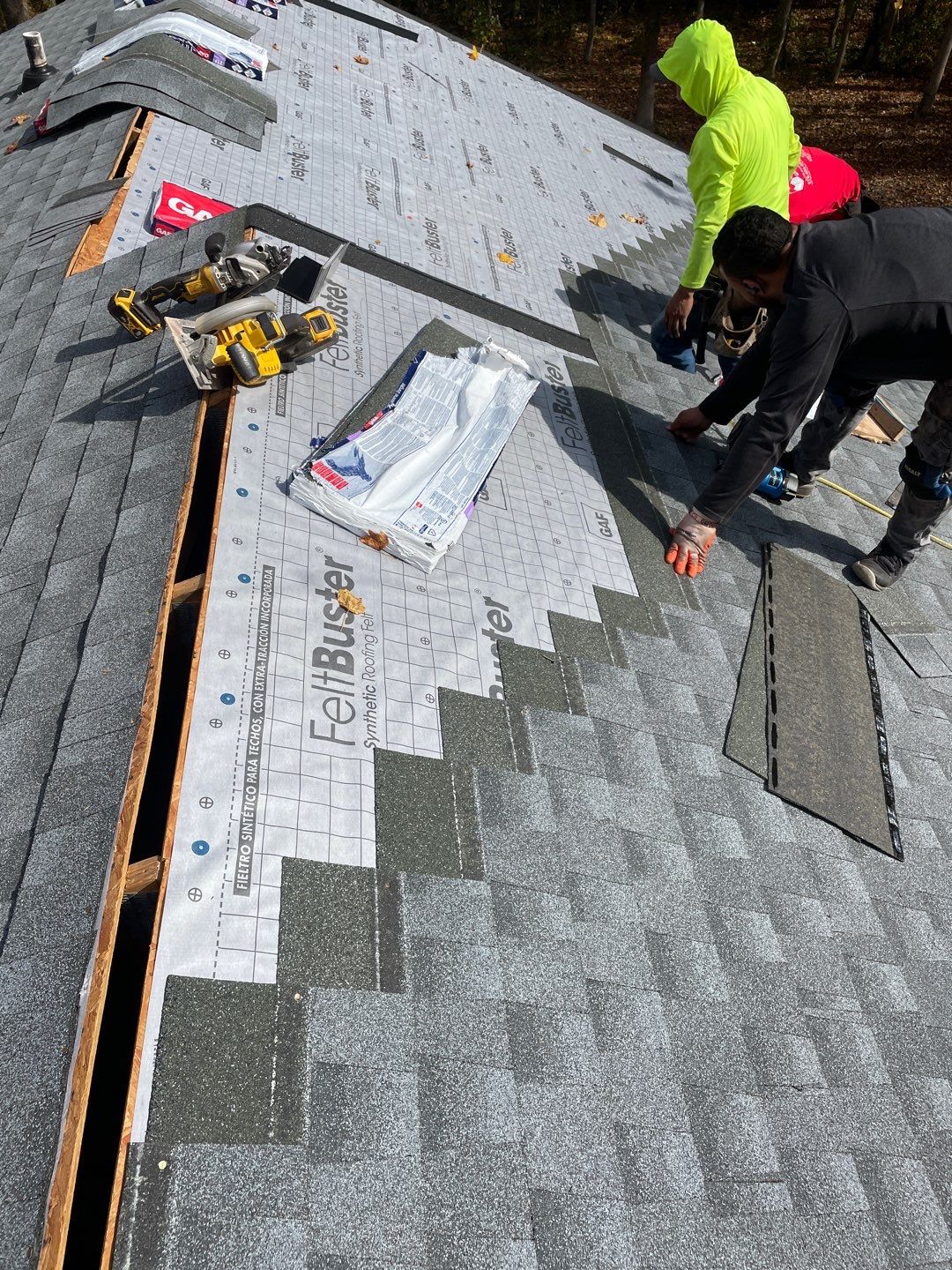A Comprehensive Consider Roofing Companies Gainesville Citizens Recommend
A Comprehensive Consider Roofing Companies Gainesville Citizens Recommend
Blog Article
Finest Practices for Ensuring Correct Roofing Ventilation
Making certain proper roofing air flow is vital for the durability and efficiency of a roofing system. A well balanced intake and exhaust vent proportion, frequently 1:300, plays an essential function, with consumption vents preferably positioned at the lower edge of the roof for trendy air access and exhaust vents at the top for warm air exit. Routine evaluations to determine obstructions and keep clear airflow are critical. Keeping insulation away from vents is crucial to prevent air flow constraint. Understanding these foundational components establishes the phase for more thorough understandings right into installment and upkeep methods that can dramatically improve your roof's performance.
Understand Air Flow Essentials
Effectively comprehending air flow basics is vital for guaranteeing the long life and effectiveness of roof covering systems. Reliable air flow alleviates moisture buildup and temperature level extremes in the attic room, both of which can lead to significant structural damages in time. A well-ventilated roof helps in protecting against typical issues such as mold development, wood rot, and ice dams, which can jeopardize the honesty of the roof products and the underlying structures.
The key goal of ventilation is to help with the movement of air, permitting a constant exchange in between the outside and interior settings. This balance is attained via a mix of consumption and exhaust vents that function together to keep optimum air flow. Consumption vents, commonly situated along the eaves or soffits, enable fresh air to go into the attic space, while exhaust vents, often situated at or near the roofing system ridge, enable hot, moist air to escape.
Key factors affecting the efficiency of roof ventilation consist of correct placement, sufficient sizing, and making certain that both intake and exhaust vents are unblocked. Routine examination and maintenance are important to identify possible clogs, damage, or inefficiencies in the air flow system, thereby securing the roofing's efficiency and resilience.
Kinds of Roof Vents
Roofing system vents play a critical duty in preserving reliable attic room ventilation and, by extension, the total health and wellness of the roof. Various kinds of roof covering vents are offered, each with unique advantages customized to details roof covering demands. Ridge vents, as an example, are mounted along the roofing's height, allowing warm, moist air to get away from the attic room. They supply continual air flow and blend flawlessly with the roofline, making them both effective and aesthetically pleasing.

Soffit vents are set up under the eaves and operate in tandem with roof vents to guarantee a balanced intake and exhaust system. By allowing cooler air to enter from below, soffit vents help with the expulsion of warm air through upper vents. Gable vents, situated on the outside wall surfaces of the attic room, deal an additional effective remedy, especially in homes with saddleback roofs.
Evaluate Your Current Air Flow

Following, think about the age and problem of your roof products and air flow parts. Older systems may not adhere to current building codes or might have worn away over time, minimizing their effectiveness. Conduct a complete evaluation to determine any type of signs of damage, such as corrosion, damages, or voids that can jeopardize the system's performance.
Furthermore, determine the attic room temperature level and moisture degrees. High temperature levels and moisture can suggest insufficient ventilation - roofing companies in gainesville florida. Utilize a hygrometer and thermometer to obtain accurate analyses, contrasting them with exterior conditions. Consistent inconsistencies recommend possible problems that require addressing.
Setup Best Practices
Efficient installment of roofing ventilation systems is vital for ensuring optimum efficiency and long life. Proper installation starts with recognizing the see it here specific ventilation requirements of the roofing system and the structure it covers. This entails determining the correct proportion of consumption to wear down vents, commonly adhering to the 1:300 rule, which states one square foot of air flow for every 300 square feet of attic floor area.

Consumption vents must be installed at the roofing system's reduced edge, usually in the soffits, to permit amazing air to enter. Exhaust vents, on the other hand, ought to be installed near or at the roofing system's top to promote the departure of cozy, wet air.
Seal all air vent links carefully to avoid air leakages and potential water infiltration. Use high-quality products and follow manufacturer standards to make sure durability and effectiveness. Furthermore, incorporating ridge vents with baffles can considerably improve air flow performance by preventing wind-driven rainfall and snow from going into the attic room.
Eventually, precise setup of roof covering ventilation systems minimizes prospective problems such as mold growth, ice dams, and structural damage, making certain the roof's honesty and the building's overall wellness.
Regular Maintenance Tips
Uniformity in maintenance methods is basic to making certain the long-lasting efficiency of roof air flow systems. Normal examinations are important, preferably done biannually-- in the spring and autumn. Throughout these evaluations, make sure that vents are without particles, nests, and other obstructions that could hamper airflow. Look this post for any type of indications of dampness accumulation or mold, as these can suggest inappropriate air flow or leaks (roofing companies).
Cleansing the vents is one more essential job. Utilize a soft brush or a vacuum to get rid of dust and particles from intake and exhaust vents. Beware not to harm the vent displays or louvers throughout the process. In addition, examine the attic room room for any signs of water damages, which can compromise the integrity of the roof.
Appropriate insulation is similarly important. Guarantee that attic insulation does not block the vents, as this can badly restrict airflow. If any type of insulation has shifted or worked out, reposition or replace it to maintain a reliable barrier.
Lastly, change any damaged or missing out on components without delay. Damaged vents, fractured roof shingles, or shabby blinking can all add to inadequate ventilation and ought to be addressed without delay. Normal upkeep ensures that the roof ventilation system functions ideally, therefore prolonging the life-span of the roof covering itself.
Conclusion
Making certain correct roof ventilation is critical for maintaining the efficiency and durability of a roof. Adherence to the 1:300 intake and exhaust vent proportion, paired with the strategic positioning of vents, is essential. Routine semiannual assessments, debris cleansing, and making certain insulation does not block airflow are check this site out important techniques. Applying these ideal methods will cultivate a well-ventilated roof covering system, thereby minimizing potential problems connected to moisture build-up and too much warmth, inevitably lengthening the roofing's life-span.
A balanced intake and exhaust vent ratio, commonly 1:300, plays a pivotal role, with consumption vents preferably put at the lower side of the roofing for amazing air entry and exhaust vents at the peak for cozy air exit. Intake vents, typically located along the soffits or eaves, allow fresh air to get in the attic room, while exhaust vents, usually situated at or near the roofing system ridge, enable hot, moist air to run away.
Soffit vents are set up under the eaves and job in tandem with roof vents to make certain a well balanced consumption and exhaust system. By permitting cooler air to get in from below, soffit vents facilitate the expulsion of hot air with top vents. Adherence to the 1:300 intake and exhaust vent proportion, coupled with the strategic placement of vents, is necessary.
Report this page